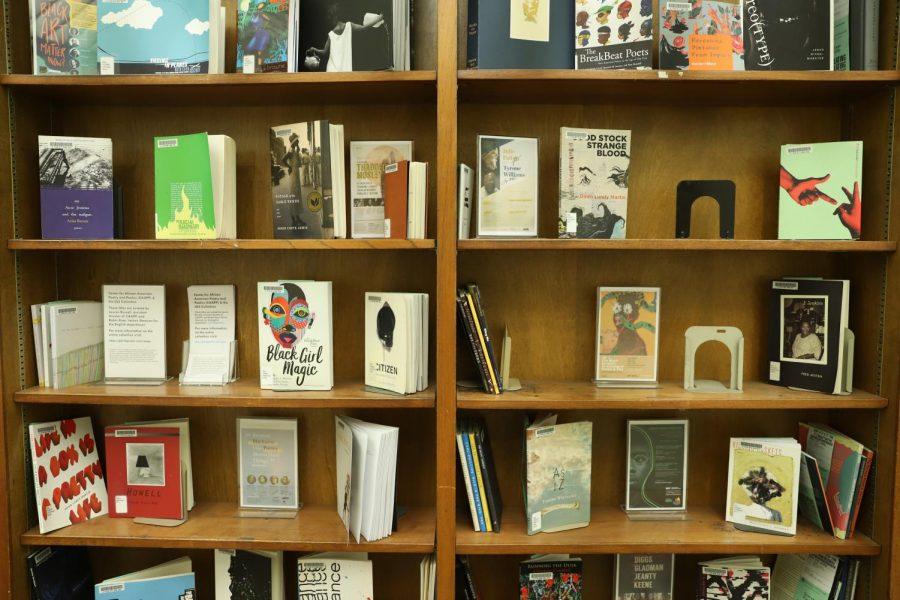Catalog of visiting black poets’ work on display in Hillman Library
Kaycee Orwig | Senior Staff Photographer
Colorful chapbooks — small collections of poetry centered on a theme — line the featured shelves in Hillman’s new African American poetry exhibit. The featured books were written and signed by black poets who have visited Pitt’s campus.
February 19, 2020
Hillman Library doesn’t typically allow visitors to write in its books — unless you’re a poet visiting with the Center for African American Poetry and Poetics.
Colorful chapbooks — small collections of poetry centered on a theme — currently line the featured shelves in Hillman’s new African American poetry exhibit. Though the content of each of these books may vary, all were written and signed by black poets who have visited Pitt’s campus.
The special collection exhibit was created in partnership between the CAAPP and the University Library System. Robin Kear, library liaison for the English department and Lauren Russell, a poet and assistant director of CAAPP, worked together to coordinate the exhibit. Since the inception of CAAPP in 2016, they’ve gathered extensive bibliographies of the poets who have visited Pitt, such as lyrical poet Simone White and Harryette Mullen, author of “House Envy of All The World,” having them sign copies of their work before they’re placed into the library system. Kear curated 41 of her favorite works by African American poets to display out of the library’s extensive collection for Black History Month.
“Whenever people are coming — the artists and the poets — Lauren will send me a list of items that we need from them,” she said. “I’ll work with Acquisitions to get them. We’ll buy out-of-print if we can if it’s a smaller edition or limited edition.”
The idea for the book signings came from CAAPP cofounder Dawn Lundy Martin. After a visit to the University at Buffalo, Martin took home its English department’s idea to honor visiting authors by getting an autographed copy of their work into the university library.
“When you give a reading [at University at Buffalo], it’s similar. They buy all the books you’ve written, including the smaller chapbooks with a limited press run if they can get them, you sign them in a special room with a special pen and it’s really lovely,” she said.
Martin said the tradition has been a great way to extend the University’s African American poetry collection while keeping an archive of the CAAPP programming thus far.
In addition to campus readings, the visiting writers often get a chance to interact directly with the student body. Russell said CAAPP has organized hands-on work between the visiting poets, such as Rickey Laurentiis, and students through the Studio in African American Poetry & Poetics course.
“The guests will circulate work in progress to the students ahead of time, and then the students present responses to the guest’s work in progress,” she said. “For some of the guests, that’s been really meaningful in helping them think about their own work.”
CAAPP has brought dozens of black writers — activists and artists like poet Fred Moten and photographer LaToya Ruby Frazier — to campus for events centered on different topics such as black futurism and poetic form. According to Martin, the process for selecting prospective visitors is fairly intuitive. She said when the time comes for picking authors to visit, the CAAPP board thinks of a theme that Martin and her cohorts from the center find interesting. Potential speakers are selected based on that theme.
“I like to invite people who [have] some interesting juxtaposition in the work that they’re doing and maybe the genres they’re working in,” she said.
Though Black History Month is over at the end of February, CAAPP has a full lineup of events throughout the rest of the semester. For those who still may not “get” poetry and are intimidated by the exhibit, Martin recommends starting with “Citizen” by Claudia Rankine as a starting point because of her prominence in the poetry community. Kear suggests picking up a book by poets Carl Phillips or Saretta Morgan, while Russell said Jonah Mixon-Webster’s “Stereo(TYPE)” is a book well worth diving into.
Multiple books by Martin and Russell themselves feature on the shelves of the exhibit as well. Martin said this particular exhibit serves as a way for students unfamiliar with the medium to become more familiar both with poetry and black artists.
“Most people don’t read poetry. A lot of people don’t teach poetry,” she said. “So this is an opportunity for them to learn about some poets that they don’t know about, to learn about some black poets they don’t know about, and to maybe incorporate those poets into their syllabi.”



